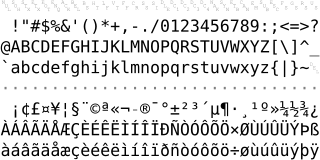
In computing, data storage, and data transmission, character encoding is used to represent a repertoire of characters by some kind of encoding system that assigns a number to each character for digital representation. Depending on the abstraction level and context, corresponding code points and the resulting code space may be regarded as bit patterns, octets, natural numbers, electrical pulses, etc. A character encoding is used in computation, data storage, and transmission of textual data. "Character set", "character map", "codeset" and "code page" are related, but not identical, terms.

ISO/IEC 8859-1:1998, Information technology — 8-bit single-byte coded graphic character sets — Part 1: Latin alphabet No. 1, is part of the ISO/IEC 8859 series of ASCII-based standard character encodings, first edition published in 1987. ISO 8859-1 encodes what it refers to as "Latin alphabet no. 1", consisting of 191 characters from the Latin script. This character-encoding scheme is used throughout the Americas, Western Europe, Oceania, and much of Africa. It is the basis for some popular 8-bit character sets and the first two blocks of characters in Unicode.
ISO/IEC 8859-3:1999, Information technology — 8-bit single-byte coded graphic character sets — Part 3: Latin alphabet No. 3, is part of the ISO/IEC 8859 series of ASCII-based standard character encodings, first edition published in 1988. It is informally referred to as Latin-3 or South European. It was designed to cover Turkish, Maltese and Esperanto, though the introduction of ISO/IEC 8859-9 superseded it for Turkish. The encoding was popular for users of Esperanto, but fell out of use as application support for Unicode became more common.
In computing, a code page is a character encoding and as such it is a specific association of a set of printable characters and control characters with unique numbers. Typically each number represents the binary value in a single byte.
A text file is a kind of computer file that is structured as a sequence of lines of electronic text. A text file exists stored as data within a computer file system. In operating systems such as CP/M and MS-DOS, where the operating system does not keep track of the file size in bytes, the end of a text file is denoted by placing one or more special characters, known as an end-of-file marker, as padding after the last line in a text file. On modern operating systems such as Microsoft Windows and Unix-like systems, text files do not contain any special EOF character, because file systems on those operating systems keep track of the file size in bytes. There are for most text files a need to have end-of-line delimiters, which are done in a few different ways depending on operating system. Some operating systems with record-orientated file systems may not use new line delimiters and will primarily store text files with lines separated as fixed or variable length records.

Windows-1252 or CP-1252 is a single-byte character encoding of the Latin alphabet, used by default in the legacy components of Microsoft Windows for English and many European languages including Spanish, French, and German.
ISO/IEC 8859-2:1999, Information technology — 8-bit single-byte coded graphic character sets — Part 2: Latin alphabet No. 2, is part of the ISO/IEC 8859 series of ASCII-based standard character encodings, first edition published in 1987. It is informally referred to as "Latin-2". It is generally intended for Central or "Eastern European" languages that are written in the Latin script. Note that ISO/IEC 8859-2 is very different from code page 852 which is also referred to as "Latin-2" in Czech and Slovak regions. Code page 912 is an extension.
ISO/IEC 8859-11:2001, Information technology — 8-bit single-byte coded graphic character sets — Part 11: Latin/Thai alphabet, is part of the ISO/IEC 8859 series of ASCII-based standard character encodings, first edition published in 2001. It is informally referred to as Latin/Thai. It is nearly identical to the national Thai standard TIS-620 (1990). The sole difference is that ISO/IEC 8859-11 allocates non-breaking space to code 0xA0, while TIS-620 leaves it undefined.
ISO/IEC 8859-4:1998, Information technology — 8-bit single-byte coded graphic character sets — Part 4: Latin alphabet No. 4, is part of the ISO/IEC 8859 series of ASCII-based standard character encodings, first edition published in 1988. It is informally referred to as Latin-4 or North European. It was designed to cover Estonian, Latvian, Lithuanian, Greenlandic, and Sami. It has been largely superseded by ISO/IEC 8859-10 and Unicode. Microsoft has assigned code page 28594 a.k.a. Windows-28594 to ISO-8859-4 in Windows. IBM has assigned code page 914 to ISO 8859-4.
ISO/IEC 8859-5:1999, Information technology — 8-bit single-byte coded graphic character sets — Part 5: Latin/Cyrillic alphabet, is part of the ISO/IEC 8859 series of ASCII-based standard character encodings, first edition published in 1988. It is informally referred to as Latin/Cyrillic. It was designed to cover languages using a Cyrillic alphabet such as Bulgarian, Belarusian, Russian, Serbian and Macedonian but was never widely used. It would also have been usable for Ukrainian in the Soviet Union from 1933–1990, but it is missing the Ukrainian letter ge, ґ, which is required in Ukrainian orthography before and since, and during that period outside Soviet Ukraine. As a result, IBM created Code page 1124.
ISO/IEC 8859-6:1999, Information technology — 8-bit single-byte coded graphic character sets — Part 6: Latin/Arabic alphabet, is part of the ISO/IEC 8859 series of ASCII-based standard character encodings, first edition published in 1987. It is informally referred to as Latin/Arabic. It was designed to cover Arabic. Only nominal letters are encoded, no preshaped forms of the letters, so shaping processing is required for display. It does not include the extra letters needed to write most Arabic-script languages other than Arabic itself.
ISO/IEC 8859-7:2003, Information technology — 8-bit single-byte coded graphic character sets — Part 7: Latin/Greek alphabet, is part of the ISO/IEC 8859 series of ASCII-based standard character encodings, first edition published in 1987. It is informally referred to as Latin/Greek. It was designed to cover the modern Greek language. The original 1987 version of the standard had the same character assignments as the Greek national standard ELOT 928, published in 1986. The table in this article shows the updated 2003 version which adds three characters. Microsoft has assigned code page 28597 a.k.a. Windows-28597 to ISO-8859-7 in Windows. IBM has assigned code page 813 to ISO 8859-7. (IBM CCSID 813 is the original encoding. CCSID 4909 adds the euro sign. CCSID 9005 further adds the drachma sign and ypogegrammeni.)
ISO/IEC 8859-9:1999, Information technology — 8-bit single-byte coded graphic character sets — Part 9: Latin alphabet No. 5, is part of the ISO/IEC 8859 series of ASCII-based standard character encodings, first edition published in 1989. It is informally referred to as Latin-5 or Turkish. It was designed to cover the Turkish language, designed as being of more use than the ISO/IEC 8859-3 encoding. It is identical to ISO/IEC 8859-1 except for these six replacements of Icelandic characters with characters unique to the Turkish alphabet:
ISO/IEC 8859-10:1998, Information technology — 8-bit single-byte coded graphic character sets — Part 10: Latin alphabet No. 6, is part of the ISO/IEC 8859 series of ASCII-based standard character encodings, first edition published in 1992. It is informally referred to as Latin-6. It was designed to cover the Nordic languages, deemed of more use for them than ISO 8859-4.
ISO/IEC 8859-13:1998, Information technology — 8-bit single-byte coded graphic character sets — Part 13: Latin alphabet No. 7, is part of the ISO/IEC 8859 series of ASCII-based standard character encodings, first edition published in 1998. It is informally referred to as Latin-7 or Baltic Rim. It was designed to cover the Baltic languages, and added characters used in the Polish language missing from the earlier encodings ISO 8859-4 and ISO 8859-10. Unlike these two, it does not cover the Nordic languages. It is similar to the earlier-published Windows-1257.
Windows code page 1253, commonly known by its IANA-registered name Windows-1253 or abbreviated as cp1253, is a Microsoft Windows code page used to write modern Greek. It is not capable of supporting the older polytonic Greek.
Several binary representations of 8-bit character sets for common Western European languages are compared in this article. These encodings were designed for representation of Italian, Spanish, Portuguese, French, German, Dutch, English, Danish, Swedish, Norwegian, and Icelandic, which use the Latin alphabet, a few additional letters and ones with precomposed diacritics, some punctuation, and various symbols. Although they're called "Western European" many of these languages are spoken all over the world. Also, these character sets happen to support many other languages such as Malay, Swahili, and Classical Latin.
Windows code pages are sets of characters or code pages used in Microsoft Windows from the 1980s and 1990s. Windows code pages were gradually superseded when Unicode was implemented in Windows, although they are still supported both within Windows and other platforms, and still apply when Alt code shortcuts are used.

Extended ASCII character encodings are eight-bit or larger encodings that include the standard seven-bit ASCII characters, plus additional characters. Using the term "extended ASCII" on its own is sometimes criticized, because it can be mistakenly interpreted to mean that the ASCII standard has been updated to include more than 128 characters or that the term unambiguously identifies a single encoding, neither of which is the case.
The ISO basic Latin alphabet is a Latin-script alphabet and consists of two sets of 26 letters, codified in various national and international standards and used widely in international communication. They are the same letters that comprise the English alphabet.



